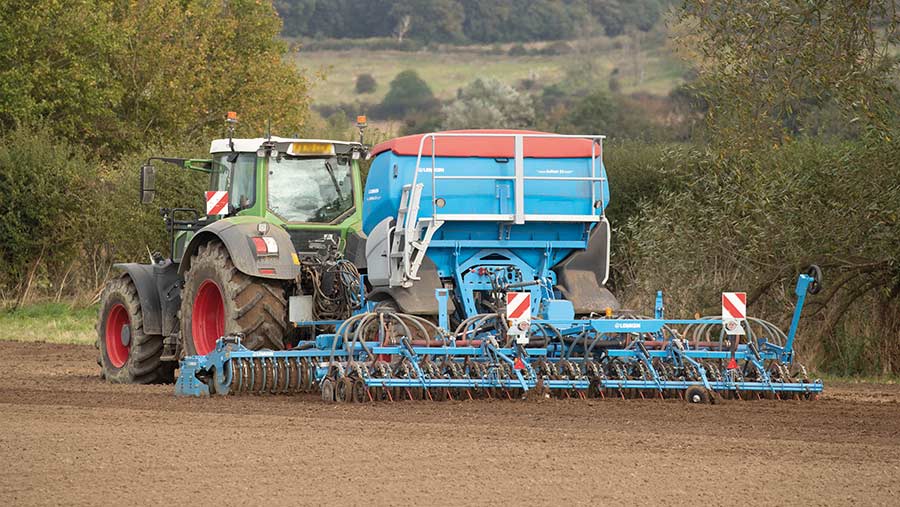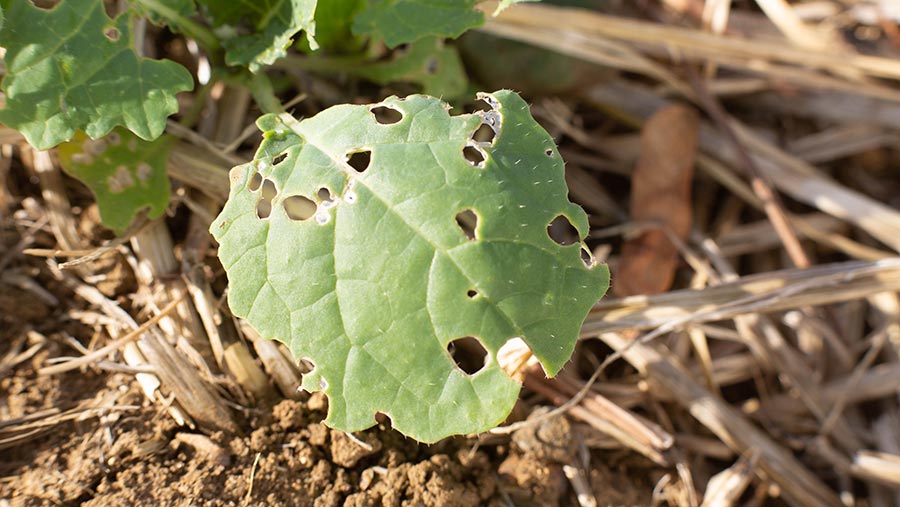Crop Watch: Late-drilled OSR battles beetles, cereals under way
 © Tim Scrivener
© Tim Scrivener Young oilseed rape plants have come under attack from cabbage stem flea beetles after a lot of rapeseed drilling was delayed due to the lack of moisture in the summer, while winter cereal drilling is now well under way.
Even with a new blackgrass herbicide available this season, cereal growers are urged to use cultural controls such as delayed drilling and high seed rates to keep the grassweed under control.
For those who have drilled early, and especially those in the milder south and west, growers are being advised to be on the lookout of aphids which can spread barley yellow dwarf virus (BYDV).
See also: Optimism for blackgrass control grows with new herbicide Luximo
East
Ben Pledger
Farmacy (Bedfordshire/Hertfordshire)
With more rain in recent days, soils are getting wetter, although there is still precious little in the way of moisture at plough depth in places.
The oilseed rape acreage is down in the area due to the lack of rain at the desired drilling time.
The rapeseed that was drilled went in the ground from about 26 August to 10 September, with mixed success.
Those who simply took seed from the shed and drilled it have, on the whole, faired worse than those who invested in a hybrid variety and applied nutrition to the crop.
Cabbage stem flea beetle numbers have been down on previous years, although the later drilling period this year has meant that there hasn’t needed to be as many to do the same amount of damage.
Winter cereal drilling is now under way, and fields are being treated with the traffic light system for blackgrass.
Green fields which are fairly clean can be drilled earlier, whereas yellow fields and red fields with higher seed banks of blackgrass will benefit from delayed drilling to allow for flushes of blackgrass to be sprayed off with glyphosate first.
Cinmethylin – the new active ingredient for the control of blackgrass in winter wheat – has shown good levels of control in trials.
However, this isn’t the “silver bullet”, and to keep levels of control high, all the other well-practiced measures still need to be employed – stale seed-beds, delayed drilling and higher seed rates will all lead to better control of blackgrass.
Keeping an eye on the bottom line and input prices seems to be a full-time job these days.
With the high price of phosphate fertilisers, alternatives are being looked at to provide crops with phosphate at lower prices than buying triple super phosphate (TSP) and applying to the seed-bed or soon after.
Microgranule fertilisers containing phosphate, such as Primary-P, are being applied down the coulter at drilling, giving a relatively small but targeted application of phosphate into the root zone.
This will promote rooting and provide the crop with a valuable root structure to take up nutrition in the spring, when levels may again be reduced from the norm due to higher fertiliser prices.
North
David Martindale
Arable Alliance (Yorkshire)
The dry weather continued for most of September until some heavy rain finally arrived at the end of the month.
This moisture has been very welcome, with oilseed rape the main beneficiary, especially on heavier soils where some crops were struggling.
A lot of cereals have now been drilled after a prolonged run of dry weather.
For fields sown several weeks ago which have grassweed issues, this early sowing may come back to bite, especially as seed-bed surfaces have remained dry which will reduce the efficacy of pre-emergence herbicides.
However, once a drill starts it is difficult to stop, with many growers understandably fearing that once it starts raining it will keep raining, especially given the experiences of recent years.

© Tim Scrivener
Cabbage stem flea beetles were late to arrive in crops this year compared with previous seasons and have been a problem throughout September.
Slow crop growth due to lack of moisture has meant fields have been vulnerable for a longer period.
Damage has certainly been higher where oilseed rape has been sown next to oilseed crops grown last year.
The early sowing of wheat into these stubbles has added to the pressure as many now homeless flea beetles have relocated into nearby oilseed rape crops.
There are a wide range of crop growth stages, with those sown early already at the eight to nine true leaf stage while mid-September crops are just putting out their first true leaves.
Where broad-leaved weeds are in abundance, herbicides such as Belkar (arylex + picloram) are now being applied, otherwise large flushes of grassweeds such as blackgrass and ryegrass are being controlled with the graminicide Centurion Max (clethodim).
Early sown cereals are already at the two to three leaf stage. However, emergence has been patchy on heavier soils due to seedbeds being dry and cloddy.
This has made the timing of the peri-emergence herbicide difficult when trying to achieve the best blackgrass control.
The recent moisture will also help soften the heavier soil clods so better seed-beds will be achieved.
This in turn will improve the performance of pre-emergence herbicides for blackgrass and ryegrass control.
It is nice to have another herbicide option for control of these grass weeds in the form of cinmethylin, which will likely reduce the pressure and reliance on flufenacet.
Slugs so far have not been an issue in cereal crops but could soon cause problems now that it has rained.
Be on the lookout for the tiny white cigar shaped eggs of gout fly which can be seen on the leaf. Egg numbers are currently low. However, this can soon change.
Where winter beans are to be sown, achieving a good seed-bed is important, not just for crop establishment but also to get the best weed control from the pre-emergence herbicides.
This includes the use of propyzamide for grassweed control, to which there is still no known resistance. Herbicide options post-emergence for broad leaved weed control are limited.
West
Neil Potts
Matford Arable (Devon)
An early harvest of both cereals and maize is leading to a generally earlier-than-usual planting period this year. The weather is helping this along by not getting too wet too soon.
Winter oilseed rape crops have generally established pretty well, with little sign of early cabbage stem flea beetle damage.
As in most seasons, slugs have represented the biggest threat to rapeseed crop establishment this year. Crops will need monitoring for early signs of light leaf spot and phoma.
Due to the extremely localised effects of rainfall, pressure could be very different from one farm to another.
Currently across the area I am collecting soil samples from fields that are quite damp and then in other fields that are not far away the ground is still very dry and quite hard.
The first winter cereal crops have now been in the ground for approaching three weeks at the time of writing.
These crops have emerged quickly and will quite obviously be at severe risk from aphids and BYDV. Daytime temperatures have been higher than average for the time of year.
I would therefore urge growers not to delay the first application of an aphicide to control what can be an absolutely devastating disease.
As we go into the autumn, spray days become fewer and further between, so it becomes even more important to get these applications on when there is a window in the weather.
Putting the first application on too late can mean that all follow up applications are wasted as the crop is already infected.
As a rule of thumb, the earlier a crop becomes infected, the worse the disease will be when it starts to manifest itself in late winter or early spring.
This autumn has seen the enthusiastic adoption of several new/newish varieties on quite a wide scale.
Bolton has led the way on the winter barley front after a good season in 2022 and the two wheats Dawsum and Champion have made inroads into what had previously been Graham and Extase markets.
It will be very interesting to see if they perform in practice as well as they appear to in trials.
I would have to say early indications from 2022 performance, albeit on a limited acreage, are encouraging.
South
Tod Hunnisett
AICC (Sussex)
Interestingly, looking back at my last Crop Watch from last season, I was spouting Einstein’s observations on repeating stuff time and time again and expecting things to change.
He might have been a clever bod but as far as farming is concerned, he was completely wrong.
I write this less than 24 hours after the world was blessed by my having been on this planet for 60 years. The last 42 have had me involved in arable farming. So why do I have so many questions?
- Why, after the record drought (hosepipe bans and all that), are there so many slugs about?
- Where did all these snails come from?
- Why, after the earliest and cheapest harvest on record, do I have clients still waiting for seed? Line breakdowns can be understood, but a total lack of communication and an arrogant, dismissive attitude is unacceptable (you know who you are).
- Has anyone ever done the sums on carbon capture from cover crops?
- Why can’t those of us who know what we’re doing be trusted with a single new active ingredient instead of something useless being forced upon us as a twin-pack?
And probably many more questions to follow.
Harvest in general, for us in the south, was quite acceptable at worst and spectacular at best.
Drilling is progressing rapidly and well, earlier than the last few, but I’m not complaining because it means I won’t get ear-ache from farmers reminding me that I advised them to delay their drilling.
Some of them have no choice because they don’t yet have any seed (I really hope this gets back to the seed companies).
If I have another 42 years, I might know the answers to some of the questions. Probably not; I’ll just have more questions.

